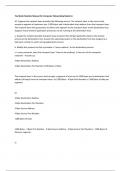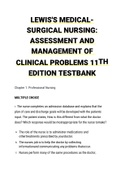Test Bank Solution Manual for Computer Networking Rated A+
R1. Suppose the network layer provides the following service. The network layer in the source host
accepts a segment of maximum size 1,200 bytes and a destination host address from the transport layer.
The network layer then guarantees to deliver the segment to the transport layer at the destination host.
Suppose many network application processes can be running at the destination host.
a. Design the simplest possible transport-layer protocol that will get application data to the desired
process at the destination host. Assume the operating system in the destination host has assigned a 4-
byte port number to each running application process.
b. Modify this protocol so that it provides a "return address" to the destination process.
c. In your protocols, does the transport layer "have to do anything" in the core of the computer
network? - Answers a)
4 Byte Destination Address
4 Byte Destination Port Number 1196 Bytes of Data
The network layer in the source host accepts a segment of max size of 1200 bytes and a destination host
address (4 bytes) from the transport layer. So 1200 Bytes - 4 Byte Port Number is 1196 Bytes of data per
segment.
b)
4 Byte Destination Address
4 Byte Destination Port Number
4 Byte Source Address
4 Byte Source Port Number
1188 Bytes of Data
1200 Bytes - 4 Byte Port Number - 4 Byte Source Address - 4 Byte Source Port Number = 1188 Bytes of
Data per segment.
c)
,Not by itself, but routers and switches read the transport layer header in order to deliver the data
segment properly to the destination host and application.
R2. Consider a planet where everyone belongs to a family of six, every family lives in its own house, each
house has a unique address, and each person in a given house has a unique name. Suppose this planet
has a mail service that delivers letters from source house to destination house. The mail service requires
that (1) the letter be in an envelope, and that (2) the address of the destination house (and nothing
more) be clearly written on the envelope. Suppose each family has a delegate family member who
collects and distributes letters for the other family members. The letters do not necessarily provide any
indication of the recipients of the letters.
a. Using the solution to Problem R1 above as inspiration, describe a protocol that the delegates can use
to deliver letters from a sending family member to a receiving family member.
b. In your protocol, does the mail service ever have to open the envelope and examine - Answers a)
This first strategy depends on a hierarchical structure. Divide the planet into regions, the regions into
sub-regions, and keep dividing until you get to the house level. One of the family members delegates to
the rest, and there is a person responsible for delivering mail to and from each sub-region within their
region.
The second strategy is a distributed structure. Give each delegate a radius to operate in. Make the
address on the envelope a GPS coordinate. Then have each delegate pass an envelope the neighbor
delegate that is closest to the destination address.
b)
No, the only required information for delivery is written in big letters on the envelope whereas the
letters contain no identifying information. In fact, opening the envelope to examine the letters will most
likely destroy this information.
R3. Consider a TCP connection between Host A and Host B. Suppose that the TCP segments traveling
from Host A to Host B have source port number x and destination port number y. What are the source
and destination port numbers for the segments traveling from Host B to Host A? - Answers Source port
number y and destination port number x.
[This is The Reverse As Above]
R4. Describe why an application developer might choose to run an application over UDP rather than
TCP. - Answers An application developer may not want its application to use TCP's congestion control,
which can throttle the application's sending rate at times of congestion. Often, designers of IP telephony
and IP videoconference applications choose to run their applications over UDP because they want to
,avoid TCP's congestion control. Also, some applications do not need the reliable data transfer provided
by TCP.
R5. Why is it that voice and video traffic is often sent over TCP rather than UDP in today's Internet?
(Hint: The answer we are looking for has nothing to do with TCP's congestion-control mechanism.) -
Answers Since most firewalls are configured to block UDP traffic, using TCP for video and voice traffic
lets the traffic though the firewalls
R6. Is it possible for an application to enjoy reliable data transfer even when the application runs over
UDP? If so, how? - Answers Yes. The application developer can put reliable data transfer into the
application layer protocol. This would require a significant amount of work and debugging, however.
R7. Suppose a process in Host C has a UDP socket with port number 6789. Suppose both Host A and
Host B each send a UDP segment to Host C with destination port number 6789. Will both of these
segments be directed to the same socket at Host C? If so, how will the process at Host C know that these
two segments originated from two different hosts? - Answers Yes, both segments will be directed to the
same socket. For each received segment, at the socket interface, the operating system will provide the
process with the IP addresses to determine the origins of the individual segments.
R8. Suppose that a Web server runs in Host C on port 80. Suppose this Web server uses persistent
connections, and is currently receiving requests from two different Hosts, A and B. Are all of the
requests being sent through the same socket at Host C? If they are being passed through different
sockets, do both of the sockets have port 80? Discuss and explain. - Answers For each persistent
connection, Web server creates a separate connection socket. Each connection socket is identified with
a four-tuple: (source IP address, source port number, destination IP address, destination port number).
When host C receives an IP datagram, it examines these four fields in the datagram/segment to
determine to which socket it should pass the payload of the TCP segment. Thus, the requests from A and
B pass through different sockets. The identifier for both of these sockets has 80 for the destination port;
however, the identifiers for these sockets have different values for source IP addresses. Unlike UDP,
when the transport layer passes a TCP segment's payload to the application process, it does not specify
the source IP address, as this is implicitly specified by the socket identifier.
R9. In our rdt protocols, why did we need to introduce sequence numbers? - Answers Sequence
numbers are required for a receiver to find out whether an arriving packet contains new data or is a
retransmission.
R10. In our rdt protocols, why did we need to introduce timers? - Answers To handle losses in the
channel. If the ACK for a transmitted packet is not received within the duration of the timer for the
packet, the packet (or its ACK or NACK) is assumed to have been lost. Hence, the packet is retransmitted.
R11. Suppose that the roundtrip delay between sender and receiver is constant and known to the
sender. Would a timer still be necessary in protocol rdt 3.0, assuming that packets can be lost? Explain. -
Answers A timer would still be necessary in the protocol rdt 3.0. If the round trip time is known then the
only advantage will be that, the sender knows for sure that either the packet or the ACK (or NACK) for
, the packet has been lost, as compared to the real scenario, where the ACK (or NACK) might still be on
the way to the sender, after the timer expires. However, to detect the loss, for each packet, a timer of
constant duration will still be necessary at the sender.
R12. Visit the Go-Back-N Java applet at the companion Web site.
a. Have the source send five packets, and then pause the animation before any of the five packets reach
the destination. Then kill the first packet and resume the animation. Describe what happens.
b. Repeat the experiment, but now let the first packet reach the destination and kill the first
acknowledgment. Describe again what happens.
c. Finally, try sending six packets. What happens? - Answers a)
R) - Packet 1 received out of order - no Packets acknowledged. Special case - No Ack sent
(R) - Packet 2 received out of order - no Packets acknowledged. Special case - No Ack sent
(R) - Packet 3 received out of order - no Packets acknowledged. Special case - No Ack sent
(R) - Packet 4 received out of order - no Packets acknowledged. Special case - No Ack sent
b)
-Cumulative Ack of Packet 0 lost.
-Simulation resumed.
(R) - Packet 1 received. Cumulative Ack for Packets up to and including 1 sent. Packet 1 delivered to
application
(R) - Packet 2 received. Cumulative Ack for Packets up to and including 2 sent. Packet 2 delivered to
application
(R) - Packet 3 received. Cumulative Ack for Packets up to and including 3 sent. Packet 3 delivered to
application
(R) - Packet 4 received. Cumulative Ack for Packets up to and including 4 sent. Packet 4 delivered to
application
c)
Java Applet does not allow six packets to be sent.
R13. Repeat R12, but now with the Selective Repeat Java applet. How are Selective





